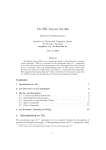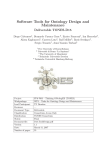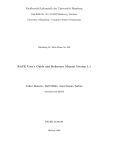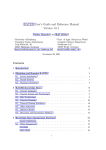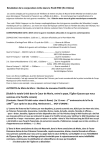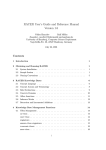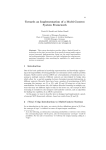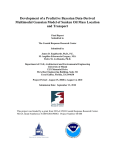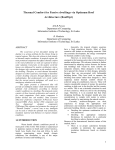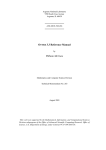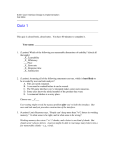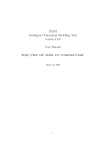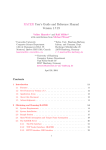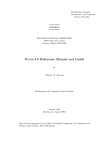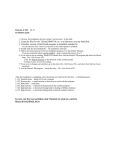Download The CEL Manual
Transcript
The CEL Manual Boontawee Suntisrivaraporn Institute for Theoretical Computer Science TU Dresden, Germany [email protected] Abstract Description logics (DLs) are an important family of formalisms for reasoning about ontologies. CEL 1 is a reasoner for the description logic EL+ , supporting as its main reasoning task the computation of the subsumption hierarchy induced by EL+ ontologies. The most distinguishing feature of CEL is that, unlike other modern DL reasoners, it implements a tractable (i.e., polynomial-time) algorithm. The supported description logic EL+ offers a selected set of expressive means that are tailored towards the formulation of medical and biological ontologies. Contents 1 Introduction to CEL 1 2 An Overview of CEL Ontologies 3 3 Macros and Functions 3.1 Concept and Role Construction . . . 3.2 Knowledge Base Declarations . . . . 3.3 Operations on the Ontology (TBox) 3.4 Query Commands . . . . . . . . . . 3.5 Other Commands . . . . . . . . . . . . . . . . . . . . . . . . . . . . . . . . . . . . . . . . . . . . . . . . . . . . . . . . . . . . . . . . . . . . . . . 4 An Example: Learning by Doing 1 . . . . . . . . . . . . . . . . . . . . . . . . . . . . . . . . . . . . . . . . 4 4 5 8 9 11 12 Introduction to CEL The description logic EL++ introduced in [1] is tailored towards the formulation of medical and biological ontologies. A distinguishing feature of EL++ compared to other description logics such as SHIQ and OWL [3, 4] is that, despite offering considerable expressivity, reasoning in EL++ is tractable, i.e., can be performed in polynomial time. 1 which stands for a polynomial-time Classifier for the description logic EL+ 1 This is clearly an advantage over the ExpTime worst-case complexity of reasoning in SHIQ and OWL. The ultimate goal of CEL is to provide a highly efficient reasoner for the description logic EL++ . A main emphasis of CEL is on reasoning with ontologies formulated in EL++ , in particular on computing the subsumption hierarchy induced by such an ontology. As of now, CEL implements a practically useful subset of EL++ that we call EL+ . More precisely, EL+ provides for the following concept constructors: • top concept “>”; • conjunction “C u D”; • existential restriction “∃r.C”. For building up ontologies, the following means of expressivity are available: • primitive concept definitions “A v D”; • concept definitions “A ≡ D”; • general concept inclusion (GCI) axioms “C v D”; • concept equivalence axioms “C ≡ D”; • transitivity assertions for roles “r ◦ r v r”; • role hierarchy axioms “r v s”; • right-identity rules “r ◦ s v r” and left-identity rules “r ◦ s v s”; • role inclusion (RI) axioms of the form “r ◦ s v t”. The ontology classification algorithm implemented in CEL has been proposed in [2]. This algorithm is a refinement for implementation purposes of the well-known polynomialtime algorithm for computing classification in EL++ giving in [1]. Currently, CEL accepts inputs in a slight extension of the KRSS (Knowledge Representation System Specification) syntax [5]. The following system requirements are assumed: • Linux operating system; • Physical memory at least 128MB.2 CEL is available as a precompiled binary package which can be run on Linux platforms. The package can be obtained from: http://lat.inf.tu-dresden.de/systems/cel/ 2 Considerably more memory may be needed for larger ontologies. 2 The package consists of the CEL executable, this user manual, the related papers [1, 2], and some example EL+ ontologies. This manual details how to get CEL up and running, how to create an ontology, and how to classify it. In Section 2, an overview of the concept and ontology language of CEL is given. In Section 3, all commands offered by CEL will be described in detail, including syntax and helpful examples. Finally, Section 4 gives a step-by-step introduction to CEL at work. 2 An Overview of CEL Ontologies Concepts and roles are built up from sets of concept and role names (which can be freely choosen by the user), using the concept and role constructors provided by EL + . The following syntax rules describe the formation of concepts and roles in CEL: C −→ CN | top | (and C1 . . . Cn ) | (some RN C) R −→ RN | (compose RN 1 RN 2 ) where CN , C, RN , and R (all possibly with subscripts) range over concept names, concepts, role names, and roles, respectively. A more detailed description of the syntax along with helpful examples is given in Section 3.1. We now give an overview of the axioms that are available for building up ontologies. Such axioms can be devided into concept axioms and role axioms. Primitive concept definitions state the necessary condition of a concept name. DL notation: CN v C CEL syntax: (define-primitive-concept CN C) Concept definitions state the definition (both necessary and sufficient conditions) of a concept name. DL notation: CN ≡ C CEL syntax: (define-concept CN C) General concept inclusions state the subsumption (or containment) between two concept descriptions. DL notation: C1 v C2 CEL syntax: (implies C1 C2 ) Concept equivalence axioms state the equivalence between two concept descriptions. DL notation: C1 ≡ C2 CEL syntax: (equivalence C1 C2 ) Role transitivity axioms assert the transitivity of a role name DL notation: RN ◦ RN v RN CEL syntax: (define-primitive-role RN :transitive t) 3 Role hierarchies assert the relationship between a role name and its super role name. DL notatioin: RN 1 v RN 2 CEL syntax: (define-primitive-role RN 1 :parent RN 2 ) Right-identity (left-identity) rules specifies a right (left) identity of another role. DL notatioin: RN 1 ◦ RN 2 v RN 1 CEL syntax: (define-primitive-role RN 1 :right-identity RN 2 ); and, DL notatioin: RN 1 ◦ RN 2 v RN 2 CEL syntax: (define-primitive-role RN 2 :left-identity RN 1 ) Role inclusions state the subsumption (or containment) between a role composition on the lhs and a role name on the rhs. DL notatioin: RN 1 ◦ RN 2 v RN 3 CEL syntax: (role-inclusion (compose RN 1 RN 2 ) RN 3 ) We note that only role-inclusion and implies are sufficient to express any EL + ontologies. The additional commands are included for ease of use and for compatibility with other DL reasoners. 3 Macros and Functions In this section, we give a detailes description of all commands offered by CEL. The commands are arranged in five groups. 3.1 Concept and Role Construction In CEL, concept and role names can be used without prior declaration. To form concept and role names, we recommend the use of alphanumerical characters, probably including symbols such as “ ” and “-”. Per default, CEL does not distinguish capital letters from lower-case ones. All symbols will automatically be capitalized when processing. In case of the need for case distinction, symbols shall be embraced within a pair of vertical bars, that is, MALE is equivalent to Male, but |MALE| is not to |Male|. Complex concepts and roles can be constructed using the constructors of EL + as summarized in the grammar on Page 3. In the following, the syntax is described in more detail. top keyword Description: Syntax: Type: The predefined, most general concept of any ontology, the top concept (>, aka logical truth). top concept constructor 4 and keyword Description: Syntax: Example: Type: N -ary conjunction (C1 u · · · u Cn ) (and C1 . . . Cn ) (and Human Male Drunk) concept constructor some keyword Description: Syntax: Example: Remarks: Type: Existential restriction (∃RN .C) (some RN C) (some has-child Male) Only atomic roles are allowed in an existential restriction concept constructor compose Description: Syntax: Example: Type: 3.2 keyword Binary role composition (RN 1 ◦ RN 2 ) (compose RN 1 RN 2 ) (compose has-parent has-brother) role constructor Knowledge Base Declarations This section introduces the commands used to build up ontologies. There are two kinds of role axiom declarations and four kinds of concept axiom declarations. 5 define-primitive-role Description: Syntax: Arguments: Example: Remarks: macro Defines a role name and its properties such as its super-roles and transitivity (define-primitive-role RN &key (transitive nil) (parent nil) (parents nil) (right-identity nil) (left-identity nil)) RN - role name :transitive - if set to t declares that the role name is transitive. :parent - specifies a super-role, or alternatively, use :parents with a singleton set, see examples. :parents - specifies a list of super roles. :right-identity - specifies a right-identity role for RN . :left-identity - specifies a left-identity role for RN . (define-primitive-role has-descendant :transitive t) (define-primitive-role conj-role :parents (r1 . . . rn )) (define-primitive-role cont-in :right-identity part-of) This macro integrates several DL role axioms. As an example, we would need two DL role axioms for the first example above: one for the transitivity (hasDescendant ◦hasDescendant v hasDescendant) and one for the role inclusion (hasDescendant v hasChild ). The arguments :left-identity and :right-identity are not part of the KRSS standard. role-inclusion Description: Syntax: Arguments: Example: Remarks: macro Asserts an inclusion between a (possibly composite) role and a role name. (role-inclusion R RN ) R - role name or binary role composite RN - role name (role-inclusion has-daughter has-child) (role-inclusion (compose has-father has-sister) has-aunt) This is a generalization of define-primitive-role. Role hierarchy, transitivity, and right-identity can be expressed in a more elegant way by using define-primitive-role. This macro is not part of the KRSS standard. 6 define-primitive-concept Description: Syntax: Arguments: Examples: Remarks: macro Asserts a subsumption relation between a concept name and a complex concept. (define-primitive-concept CN C) CN - concept name C - (possibly complex) concept (define-primitive-concept Father Man) (define-primitive-concept GrandMother (and Mother Female)) This macro states the necessary conditions for CN . define-concept Description: Syntax: Arguments: Examples: Remarks: macro Defines a concept name. (define-concept CN C) CN - concept name C - (possibly complex) concept (define-concept Father (and Man (some has-child Human))) This macro states both the necessary and sufficient conditions for CN . In CEL, a concept name may have multiple definitions. concept-inclusion , implies Description: Syntax: Arguments: Examples: Remarks: macro Asserts a general concept inclusion (GCI) between two concepts. (implies C1 C2 ) C1 , C2 - (possibly complex) concepts (implies (and Man (some has-sibling Parent)) Uncle) The equivalent DL notation is C1 v C2 . equivalent Description: Syntax: Arguments: Examples: Remarks: macro Asserts an equivalence between two concepts. (equivalent C1 C2 ) C1 , C2 - (possibly complex) concept (equivalent (and Man (some has-sibling (some has-child Female)) (and Uncle (some has-niece top)))) The equivalent DL notation is C1 ≡ C2 . 7 3.3 Operations on the Ontology (TBox) clear-ontology , clear-tbox Description: Syntax: Remarks: macro Removes all axioms and initializes everything. (clear-tbox) This macro is internally called whenever a new ontology is loaded. load-ontology , load-tbox Description: Syntax: Arguments: Remarks: macro Reads in and and normalizes the input ontology. (load-tbox tboxfile) tboxfile - path of the input ontology file. If a filename is given without path, the ontology is assumed to be either in the current directory, or in the subdirectory ./tboxes. The file specified by tbox-file is assumed to contain a list of commands as shown in Subsection 3.2. After having successfully loaded the ontology, it is ready to be classified, see the next command. classify-ontology , classify-tbox Description: Syntax: Remarks: macro Classifies the loaded and normalized ontology. (classify-tbox &key (mode 2)) Classify the current ontology depending on the mode of classification, which is defaulted to 2. In the classification mode 1, CEL additionally computes the Hasse diagram, i.e., a directed acyclic graph (DAG) of the terminological hierarchy. As a consequence, classification in mode 1 usually takes longer time on the same ontology, but it also provides users with additional features thereafter. ontology-prepared? , tbox-prepared? Description: Syntax: Remarks: macro Checks if the ontology is prepared for classification. (tbox-prepared?) This is a fundamental requirement for (classify-tbox). ontology-classified? , tbox-classified? Description: Syntax: Remarks: macro Checks if the ontology is successfully classified. (tbox-classified?) This test must be positive before any subsumption queries can be carried out. 8 3.4 Query Commands concept? Description: Syntax: Arguments: macro Checks if the given name is known as a concept name. (concept? CN ) CN - name to be tested all-concepts Description: Syntax: macro Retrieves the list of all concept names occurring in the ontology. (all-concepts) concept-subsumes? , subsumes? Description: Syntax: Arguments: Remarks: macro Queries if one concept name subsumes the other. (concept-subsumes? CN1 CN2 ) CN1 , CN2 - concept names This macro only performs a lookup in the preclassified concept hierarchy; it cannot be called before the test (tbox-classified?) is positive. DL equivalent notation is CN2 v?T CN1 . In the current version of CEL, it is not possible to query the subsumption of complex concepts w.r.t. the classified ontology. To perform such a subsumption query, introduce two new names for the complex concepts in the subsumption query using defineconcept, re-classify the augmented ontology, and then use conceptsubsumes? to check subsumption between the newly introduced concept names. concept-implies? , implies? Description: Syntax: Arguments: Remarks: macro Queries if one concept name implies (is subsumed by) the other. (concept-implies? CN1 CN2 ) CN1 , CN2 - concept names Identical to concept-subsumes, but with swapped arguments concept-equivalent? , equivalent? Description: Syntax: Arguments: macro Queries if two concept names are equivalent (i.e., subsume each other) (concept-equivalent? CN1 CN2 ) CN1 , CN2 - concept names 9 parents Description: Syntax: Arguments: Remarks: macro Returns a list of direct subsumers of a concept name. (parents CN ) CN - concept name This feature is available only after classification in mode 1 children Description: Syntax: Arguments: Remarks: macro Returns a list of direct subsumees of a concept name. (children CN ) CN - concept name This feature is available only after classification in mode 1 ancestors , super-concepts Description: Syntax: Arguments: macro Returns a list of all (direct and indirect) subsumers of a concept name. (ancestors CN ) CN - concept name descendants , sub-concepts Description: Syntax: Arguments: macro Returns a list of all (direct and indirect) subsumees of a concept name. (descendants CN ) CN - concept name role? Description: Syntax: Arguments: macro Checks if the given name is known as a role name. (concept? RN ) RN - name to be tested all-roles Description: Syntax: macro Retrieves the list of all role names occurring in the ontology. (all-roles) role-subsumes? Description: Syntax: Arguments: Remarks: macro Queries if one role name subsumes the other. (role-subsumes? RN1 RN2 ) RN1 , RN2 - role names DL equivalent notation is RN2 v?T RN1 . 10 role-implies? Description: Syntax: Arguments: Remarks: macro Queries if one role name implies (is subsumed by) the other. (role-implies? RN1 RN2 ) RN1 , RN2 - role names Identical to role-subsumes?, but with swapped arguments transitive? Description: Syntax: Arguments: 3.5 macro Checks if a role name is specified as transitive. (transitive? RN ) RN - role name Other Commands start function Description: Syntax: Arguments: Remarks: Loads, preprocesses, and classifies the ontology, all in one command. (start tboxfile &key (mode 2) (verbosity 2)) tboxfile - path string pointing to the input ontology file. mode - mode of classification; when set to 1, CEL additionally computes the Hasse diagram. verbosity - the level of verbosity CEL talks to its interactive users. 0 or nil for none, 1 for crutial messages, 2 for normal messages, t for everything. See load-ontology and classify-ontology. output-subsumption Description: Syntax: Arguments: macro Outputs all computed subsumption relationships pair by pair. (output-subsumption [filename]) filename - file name, possibly with path, to which the subsumption relationships are written. If not given, the output is written on the console screen. output-imp-sets Description: Syntax: Arguments: macro Outputs all computed subsumption relationships in the form of implication sets. (output-imp-sets [filename]) filename - file name, possibly with path, to which the subsumption relationships are written. If not given, the output is written on the console screen. 11 output-synonyms Description: Syntax: Arguments: macro Outputs sets of told synonyms and their representative. (output-synonyms [filename]) filename - file name, possibly with path, to which the subsumption relationships are written. If not given, the output is written on the console screen. output-hierarchy Description: Syntax: Arguments: Remarks: macro Outputs a visualized representation of the computed taxonomy. (output-hierarchy [filename]) filename - file name, possibly with path, to which the subsumption relationships are written. If not given, the output is written on the console screen. This feature is available only after classification in mode 1. With large input ontologies, outputs in this format might become a mess and could be very large. output-hasse Description: Syntax: Arguments: Remarks: 4 macro Outputs the computed Hasse diagram by identifying the parents and children of each concept name. (output-hasse [filename]) filename - file name, possibly with path, to which the subsumption relationships are written. If not given, the output is written on the console screen. This feature is available only after classification in mode 1 An Example: Learning by Doing In this section, we illustrate the use of CEL step by step. This includes • creating an ontology, • starting up the reasoner, • loading the ontology, • classifying the ontology, • querying subsumptions, and • output the classification. 12 Creating an Ontology CEL is a reasoning backend, and as such does not provide an ontology editor to create and maintain ontologies. Any ontology editor that produces KRSS syntax and supports (a subset of) the expressive means provided by EL+ can be used together with CEL. To get started, it is perhaps advisable to generate some simple ontologies using a standard text editor such as emacs. The following simple ontology is provided as the file ./tboxes/med.tbox of the CEL distribution. The concept name HDSNT is an abbreviation for “heart desease needing treatment”. (define-primitive-role cont-in :parent comp-of) (implies Pericardium (and Tissue (some cont-in Heart))) (implies Pericarditis (and Inflammation (some has-loc Pericardium))) (implies Inflammation (and Disease (some acts-on Tissue))) (implies (and Disease (some has-loc (some comp-of Heart))) (and Heartdisease (some has-state NeedsTreatment))) (define-concept HDSNT (and Heartdisease (some has-state NeedsTreatment))) Starting up the reasoner CEL can be started by simply calling the executable in the ./bin subdirectory of the distribution. After the reasoner has been successfully loaded, the greeting screen will appear and CEL will prompt for commands from the user. Loading the ontology At the prompt, write down the following command: (load-ontology "med.tbox") CEL searches for the specified ontology not only in the current directory but also in the directory ./tboxes. A full path to the ontology file can also be given. Classifying the Ontology After having read in and preprocessed the ontology, CEL is ready to classify it. The user may want to check this status by asking (ontology-prepared?) The answer will then be t, i.e., “yes”. At this point, the classification can be started by calling the command 13 (classify-ontology) This may take some time depending on the size and complexity of the ontology. To load and classify an ontology in one step, the start function can be used. Querying Subsumption When the ontology has successfully been classified (to check this, call (ontology-classified?)), subsumption between two concept names w.r.t. the classified ontology can be queried. In the example ontology above, the user might want to know if Pericarditis is in fact a heart disease needing treatment. This can be checked by querying (concept-subsumes? HDSNT Pericarditis). The set of all subsumers and subsumees of a concept name can also be obtained by using ancestors and descendants, respectively. Output the Classification After the classification, the concept hierarchy can be archived in a file or displayed on screen by using the functions output-subsumption and output-imp-sets, depending on the format and brevity needed. If the classification has been carried out in mode 1, it is additionally possible with output-hasse to output the most compact representation of a taxonomy, i.e., Hasse diagram. By using output-hierarchy, a visualization of the terminological hierarchy can be displayed. Moreover, (maximal) sets of pairwise subsuming concept names (called synonyms) can be displayed by the function output-synonyms. Please refer to the more detailed explanation in Section 3.5. References [1] F. Baader, S. Brandt, and C. Lutz. Pushing the EL envelope. In IJCAI-05, Edinburgh, UK, 2005. Morgan-Kaufmann Publishers. [2] Franz Baader, Carsten Lutz, and Boontawee Suntisrivaraporn. Is tractable reasoning in extensions of the description logic EL useful in practice? In Proceedings of the 2005 International Workshop on Methods for Modalities (M4M-05), 2005. [3] I. Horrocks, P. F. Patel-Schneider, and F. van Harmelen. From SHIQ and RDF to OWL: The making of a web ontology language. Journal of Web Semantics, 1(1):7–26, 2003. [4] D. L. McGuinness and F. van Harmelen. OWL web ontology language overview. See http://www.w3.org/TR/owl-features/, 2004. [5] P. Patel-Schneider and B. Swartout. Description-logic knowledge representation system specification from the krss group of the arpa knowledge sharing effort. Technical report, DARPA Knowledge Representation System Specification (KRSS) Group of the Knowledge Sharing Initiative, 1993. 14














